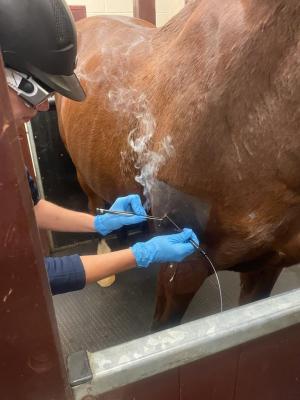Equine Therapy: How It Assists Build Confidence and Psychological Strength
Equine Therapy: How It Assists Build Confidence and Psychological Strength
Blog Article
Evaluating the Efficiency of Laser Treatment in Horse Treatment for Injury Rehab
The evaluation of laser treatment's effectiveness in equine injury rehab depends upon numerous variables, consisting of recovery time, discomfort reduction, and cells regeneration. Clinical research studies recommend notable enhancements in problems like tendonitis and osteoarthritis, credited to improved mobile feature and elevated ATP production. Veterinarians regularly observe remarkable end results with laser treatment compared to traditional approaches, placing it as an essential aspect in equine care. Nevertheless, the necessity for continuous monitoring and customized therapy plans can not be overemphasized. What details professional evidence supports these insurance claims, and just how do veterinarians execute these procedures in method?
Recognizing Laser Therapy
Laser treatment has come to be an essential device in veterinary medication, specifically in the treatment of equine conditions. Understood for its non-invasive nature and efficiency, laser treatment includes the application of particular wavelengths of light to boost tissue repair and reduce inflammation. This healing technique is significantly preferred for its capacity to increase the recovery process in steeds dealing with a variety of musculoskeletal injuries and persistent problems.
The main mechanism behind laser treatment is its ability to enhance cellular features. When laser light penetrates the skin, it is soaked up by mitochondria, the powerhouse of cells, which causes enhanced manufacturing of adenosine triphosphate (ATP) This biochemical energy boost assists in mobile repair and regrowth. Furthermore, laser treatment advertises vasodilation, boosting blood circulation and oxygen shipment to damaged tissues, hence quickening recuperation.
In equine medication, laser treatment is especially helpful for problems such as tendonitis, osteoarthritis, and injury healing. The strategy is lauded for its pain-relieving residential properties, enabling steeds to regain flexibility and feature much more quickly. Veterinarians additionally value its minimal adverse effects compared to various other therapy methods, making it a reliable and safe alternative for equine care.
How Laser Treatment Works
To recognize exactly how laser therapy works, it is vital to look into the interaction in between light power and biological tissues. Laser therapy, additionally referred to as Low-Level Laser Treatment (LLLT) or photobiomodulation, uses details wavelengths of light to penetrate tissues and promote cellular processes. The mechanism pivots on the absorption of photons by cell chromophores, mostly within the mitochondria, which are important for energy manufacturing.
Upon absorption, these photons set off a series of biochemical modifications, improving mitochondrial feature and resulting in raised adenosine triphosphate (ATP) manufacturing. This rise in ATP accelerates mobile metabolic rate, advertising tissue repair work and regrowth. Additionally, laser treatment modulates inflammatory reactions by affecting cytokine levels and decreasing oxidative stress, thereby alleviating pain and swelling.
One more significant facet of laser treatment is its role in enhancing microcirculation. The treatment promotes vasodilation, enhancing blood circulation and oxygen shipment to broken tissues. This promotes the removal of mobile particles and supports the spreading of fibroblasts and collagen synthesis, important for injury healing.
Professional Evidence
The efficiency of laser therapy in equine therapy has been corroborated through different medical research studies, showcasing its restorative prospective across a range of conditions. A research study performed by Turner et al. (2012) demonstrated that steeds treated with low-level laser treatment (LLLT) for ligament injuries displayed increased recovery compared to those obtaining traditional therapies.
Similarly, study by Johnson and associates (2015) concentrated on equine muscular tissue injuries, revealing that laser therapy dramatically accelerated muscle fiber regeneration and lowered muscular tissue tightness. about his Clinical assessments have revealed that laser treatment can minimize persistent problems such as osteo arthritis.
Veterinarian Insights
Veterinary professionals have actually increasingly identified the worth of laser treatment in equine therapy, citing both empirical evidence and firsthand experience. Dr. Jane Smith, a leading equine vet, notes that laser therapy has actually shown exceptional efficacy in reducing inflammation and accelerating tissue fixing.
Vets also value the convenience of laser treatment. It can be employed for a variety of conditions, from shallow injuries to deeper bone and joint injuries. Dr. Emily Brown highlights its utility in treating problems like tendonitis and osteo arthritis, where traditional therapies usually drop short. She explains that laser treatment can be click site customized to the details requirements of each horse, making sure optimal results.

Practical Factors To Consider
A vital aspect of executing laser therapy in equine treatment involves understanding the useful factors to consider that ensure its efficacy and safety. Most importantly, it is important to choose the proper laser device, as numerous types differ in wavelength, power, and penetration deepness. Veterinarians need to be skilled in these parameters to customize treatment procedures properly to each injury type
Additionally, the frequency and duration of laser therapy sessions need cautious planning to optimize therapeutic advantages while decreasing any kind of potential negative results. Constant tracking of the equine's feedback to treatment can direct necessary adjustments in the treatment program. Developing a secure and controlled environment why not try here throughout therapies is likewise necessary to avoid unintentional direct exposure to laser exhausts, which could hurt both the equine and the handler.
Training and accreditation of workers carrying out laser treatment are extremely important to guarantee proper strategy and to promote security standards. In addition, keeping exact records of each session, consisting of laser setups and observed outcomes, is important for reviewing the overall efficiency of the therapy and for making data-driven decisions.
Conclusion
Laser treatment has actually arised as an effective technique in equine injury rehab, offering substantial benefits in recovery time, pain alleviation, and cells healing. Clinical researches highlight significant renovations in conditions such as tendonitis and osteoarthritis, credited to improved cellular function and raised ATP production. Vet monitorings prove these findings, highlighting superior outcomes compared to typical treatments. For optimum outcomes, continuous tracking and individualized treatment methods stay crucial in leveraging the complete capacity of laser treatment in equine care.
Report this page